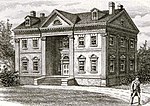PS 166 (Manhattan)

Public School 166, the Richard Rodgers School of Arts & Technology, is a public school administered by the New York City Department of Education and located in the city's Upper West Side neighborhood of the borough of Manhattan. An elementary school, it serves about 600 pupils in kindergarten through fifth grade.The building, located on West 89th Street between Columbus and Amsterdam avenues, was designed by C. B. J. Snyder and opened in September 1899. It was completely renovated and modernized in 1995 and designated a New York City landmark in 2000. Although the school is still referred to as PS 166, it was formally renamed in honor of former student Richard Rodgers in 2003.
Excerpt from the Wikipedia article PS 166 (Manhattan) (License: CC BY-SA 3.0, Authors, Images).PS 166 (Manhattan)
West 89th Street, New York Manhattan
Geographical coordinates (GPS) Address External links Nearby Places Show on map
Geographical coordinates (GPS)
| Latitude | Longitude |
|---|---|
| N 40.788997222222 ° | E -73.972536111111 ° |
Address
Public School 166
West 89th Street 132
10024 New York, Manhattan
New York, United States
Open on Google Maps







